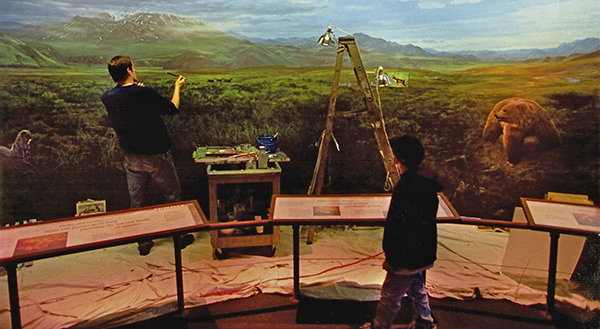If you’ve visited some of the nation’s top museums and education centers, chances are you’ve seen the work of Robert Evans ’79, a professional muralist for the past 25 years.
A double major in English and visual studies at Dartmouth, Evans’ sweeping creations are precise, visually appealing, and honest. Topics vary from the scientific, such as shorebirds for the New England Aquarium, to the historic, such as the life of George Washington for the Mount Vernon Estate Museum.
Taking anywhere from weeks to many months, each mural is an intensive interdisciplinary project that requires significant graphic planning and historical research.
For the Early Peoples Cyclorama at the North Dakota Heritage Center in the North Dakota state capitol building, Evans met regularly with a team of consultants, including archeologists, anthropologists, and representatives of the Mandan Native American tribe, which was to be featured in the mural.
“Every aspect is vetted,” says Evans. “The research and design is at least half the project.”
The final mural, completed in 2014, is a vibrant 50-foot long cyclorama of a Mandan village along the Missouri River in the 1600s. The mural is accompanied by an 11-minute audio track that educates schoolchildren, tourists, and other visitors about the people depicted.
“It’s a you-are-there type of experience,” says Evans. “It’s a way of giving a view of the culture, and artifacts, and people that is perhaps more complete—and it invites, and hopefully deserves, re-inspection, and reviewing.”

At Dartmouth, professors Varujan Boghosian and Matthew Wysocki responded favorably to Evans’ work and encouraged him. “I took Boghosian’s basic design class as a sophomore. It clicked, he loved what I was doing, and I had a lot of fun. I was lucky that I took the class in the fall term because one of our projects was leaf collages—I had a blast with that.”
Following a Reynolds Fellowship at the Ruskin School of Fine Art in England, Evans spent three years working for scenic studios in Boston before setting off independently in 1990. “The mural painting was meant to support my real art—capital A,” he says. “But it became so labor intensive that I started to focus on it exclusively, which I’ve been doing for the past 25 years.”
The artist notes that recent innovations in technology have provided him with some benefits, and challenges. For one, his craft is less specialized, as new software has opened up the field to more artists. On the other hand, he is able to work more often in his office on a desktop, as opposed to on the scaffolding. “My ankles appreciate that,” he says.
Evans has faith that the public will continue to value murals in the face of new, competing graphics. “Images on screens are stunning, but they’re dispensable,” he says. “Murals are a traditional art form. They are a solid way of documenting culture and history, and giving it life.”

